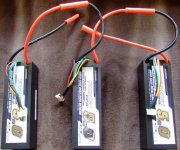A basic ebike battery using lipo packs can be made as easily as connecting 2 or more packs together like pictured below. Just like the way you connect your SLA batteries. Add another group of the same packs to double capacity and so on.

E-S member jkbrigman has a thread with good pictures where he assembled a basic battery from several packs to try lipo. If you read his thread before and after the post about his test battery below he also writes about charging.
jkbrigman: 18S Series Harness
http://endless-sphere.com/forums/viewtopic.php?f=14&t=36097&p=540976#p540966
E-S member Warren Beauchamp has an excellent tutorial below, with good pictures and diagrams, about using lipo.
Warren Beauchamp's RC E-Bike Drivetrain tutorial
http://recumbents.com/wisil/e-bent/rc_drive/tutorial.htm

E-S member jkbrigman has a thread with good pictures where he assembled a basic battery from several packs to try lipo. If you read his thread before and after the post about his test battery below he also writes about charging.
jkbrigman: 18S Series Harness
http://endless-sphere.com/forums/viewtopic.php?f=14&t=36097&p=540976#p540966
E-S member Warren Beauchamp has an excellent tutorial below, with good pictures and diagrams, about using lipo.
Warren Beauchamp's RC E-Bike Drivetrain tutorial
http://recumbents.com/wisil/e-bent/rc_drive/tutorial.htm

